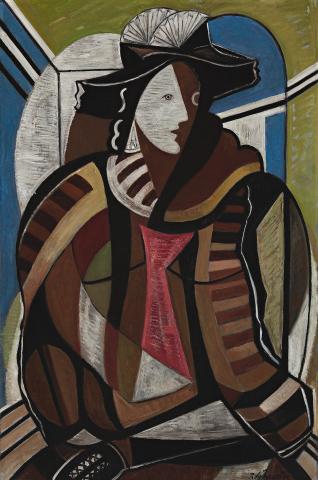SEATED FIGURE (PORTRAIT OF ANN, LADY BUTLER), c.1954
ROY DE MAISTRE
oil on board
64.5 x 41.5 cm
signed lower right: R de Maistre
Maude and Nigel Gosling, United Kingdom,
a gift from the artist, early 1950s
Christie’s, Melbourne, 22 August 2005, lot 49
Eve Breuer Art Dealer, Sydney (label attached verso)
Private collection, Adelaide
Seated Figure (Ann, Lady Butler), 1954, oil on board, 91.6 x 61.1 cm, collection Ulster Museum, Belfast, Northern Ireland, illus. in: Johnson, H., Roy de Maistre: The English Years 1930-1968, Craftsman House, Sydney, 1995, pl. 19, p. 43 (illus.); Roy de Maistre: A Retrospective Exhibition…1917-1960, Whitechapel Art Gallery, London, May–June 1960, pl. XIII, cat. 95 (illus. exhibition catalogue)
As a young art student, Roy de Maistre and his colleagues would avidly discuss, analyse and replicate the various modern art images that had begun to appear sporadically in Australian newspapers. By the late 1920s, it was increasingly apparent that Picasso had become the major inspiration for de Maistre, a passion he was to share with the young Francis Bacon when their paths became joined in 1930. Bacon and de Maistre were both avid readers of the magazine Cahiers d’Art which often contained images of Picasso’s work, and de Maistre also became fascinated by the formal design possibilities of other key cubists such as Auguste Herbin and Jean Metzinger.1 Such a path was not unexpected, for de Maistre had already demonstrated his interest in design in Sydney in the late 1920s through photographic backdrops, furniture design and interiors.
De Maistre also initiated a personal regime whereby he would often do multiple versions of the same subject, stating that ‘I find one must continually repeat oneself to define the meaning, until the moments of contemplation and the moments of creation fuse together.’;2 and Seated Figure (Portrait of Ann, Lady Butler), c.1954 is one of three known versions of the subject. Ann, Lady Butler, was the mother of one of the artist’s closest friends and patrons Rab Butler, whom de Maistre had met in Sydney in 1927 whilst Butler and his wife Sydney (née Courtauld) were honeymooning. The original portrait of Lady Butler (c.1935) is directly representational but austere, one where ‘de Maistre used the sitter’s clothes, fur, long earrings and hat in the dramatic way she used them herself, to echo the assertive person inside.’3 It would be almost twenty years before de Maistre returned to the subject, creating two further works underpinned by a schematic Cubist-informed design. The larger painting (Seated Figure (Ann, Lady Butler), 1954) is in the collection of the Ulster Museum, Belfast. In both, de Maistre employs Picasso’s dual-portrait face, where one half appears as a profile. Picasso particularly employed this technique during the early 1930s in works such as Marie-Thérèse, face and profile 1931 (Solomon R. Guggenheim Museum) and Girl before a mirror 1934 (Museum of Modern Art); and it should be remembered that these were the key years when de Maistre and Francis Bacon were studying his work. There are subtle differences between the two abstractions – in the detail of the earrings, the wave of the hair and the fans of the headdress – but both reveal the artist’s firm control of brushwork, alternating passages of smooth paint with stippled areas to emphasise visual interest. The reworked setting for Lady Butler is also of note, with the fragmented lines of the wall space evoking de Maistre’s own famed studies of Francis Bacon’s studios in the 1930s.
1. See: Harrison, M. and Daniels, R., ‘Australian Connections’, in: Bond, A. (ed.), Francis Bacon: Five Decades, Art Gallery of New South Wales, Sydney, 2012, pp. 33-34
2. Morrow, R. and Dundas, K., ‘Roy de Maistre’, Art and Australia, Sydney, vol. 2, no. 1, May 1964, p. 42
3. Johnson, H., Roy de Maistre: the English Years 1930 – 1968, Craftsman House, Sydney, 1995, p. 41
